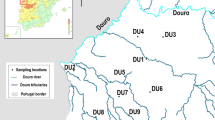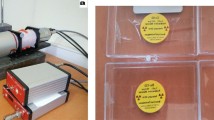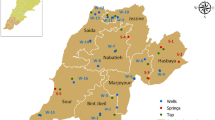Abstract
Since the introduction of the European Council Directive 2013/51 Euratom in October 2013, the analysis of drinking water has increasingly become the focus of many laboratories in Europe. The activity of tritium, radon and the gross α/β-activity is determined routinely. In order to cope with the increased sample numbers and to reach the necessary detection limits, sensitive measuring devices are required. This work was done with the new Quantulus GCT 6220 to test the sensitivity of this system for drinking water analysis. The results indicate that this instrument is very well suited for this type of analysis and counting times are typically below the required counting times of established systems.

Similar content being viewed by others
References
Council Directive 2013/51/Euratom of 22 October 2013 http://eur-lex.europa.eu/LexUriServ/LexUriServ.do?uri=OJ:L:2013:296:0012:0021:EN:PDF
Belanová A, Merešova J, Vršková M (2009) In: Eikenberg J, Jäggi M, Beer H (eds) Advances in liquid scintillation spectrometry, proceedings of the 2008 International liquid scintillation Conference Davos, Switzerland, determination of natural radionuclides in water from Slovakia using LSC, 71–76
Landstetter C, Katzlberger C (2006) In: Chalupnik S, Schönhofer F, Noakes J (eds) Advances in liquid scintillation spectrometry, proceedings of the 2005 International liquid scintillation Conference Katowice, Poland, rapid method for determining natural radionuclides in drinking water, 181–189
Landstetter C, Katzlberger C (2010) In: Cassette P (ed) Advances in liquid scintillation spectrometry, proceedings of the 2010 International Conference on advances in liquid scintillation spectrometry Paris, France, relevant radionuclides for the calculation of the total dose in Austrian drinking water, 73–79
Top G, Algin E (2009) Tritium measurements in drinking water in Eskisehir. Balk Phys Lett 16:161019
Chmielewska I, Chalupnik S, Michalik B (2010) In: Cassette P (ed) Advances in liquid scintillation spectrometry, proceedings of the International Conference on advances in liquid scintillation spectrometry, methods for determination of natural radioactivity in drinking water samples, 107–113
Salonen L (2010) Calibration of the direct LSC method for radon in drinking water: interference from 210Pb and its progenies accumulated in 226Ra standard solution. Appl Radiat Isot 68:131–138
Harazin R R (2016) United States Patent, Patent No.: US 9,297,909 B2
Dias FF, Taddei MHT (2009) Rn-222 Determination in drinking water samples in a region with elevated natural radioactivity in Brazil: comparision between liquid scintillation counting and gamma spectrometry. TERRÆ 6:72–76
Schubert M, Kopitz J, Chalupnik S (2014) Sample volume optimization for radon-in-water detection by liquid scintillation counting. J Environ Radioact 134:109–113
Pates JM, Mullinger NJ (2007) Determination of 222Rn in fresh water: development of a robust method of anaylsis by α/β separation liquid scintillation spectrometry. Appl Radiat Isot 65:92–103
Lopes I, Madruga M J, Carvalho F P (2002) Development and application of liquid scintillation counting technique to gross alpha, gross beta and radon measurements in waters, ITN, Department of Radiological Protection and Nuclear Safety, ITN Annual Report. http://www.itn.pt/docum/relac/2002/dprsn.%pdf
Cfarku F, Bylyku E, Daci B (2010) Gross alpha/beta measurements in drinking water samples using different methods. J Int Environ Appl Sci 5:287–290
Hamzah Z, Alias M, Ishak A K, Saat A (2011) Assessment of liquid scintillation technique for measurement of gross alpha and gross beta in aqueous environmental samples, 3rd International Confernce on chemical, biological and environmental engineering. IPCBEE 20:71–74 http://www.ipcbee.com/vol20/13-ICBEE2011E10016.%pdf
Abdellah WM (2013) Optimization method to determine gross alpha-beta in water samples using liquid scintillation counter. J Water Resour Prot 5:900–905
Schönhofer F, Henrich E (1987) Recent progress and application of low level liquid scintillation counting. J Radioanal Nucl Chem 115:317–333
Passo C J, Kessler M J (1993) In: Noakes J E, Schönhofer F, Polach H A (eds) International Conference on advances in liquid scintillation spectrometry Vienna, Austria, selectable delay before burst—a novel feature to enhance low-level counting performance, radiocarbon 51–57
Cook GT, Anderson R, Harkness DD, Naysmith P (1991) In: Ross H, Noakes JE, Spaulding JD (eds) Liquid scintillation counting and organic scintillators, the optimization of scintillation counters employing burst counting circuitry. Lewis publishers, Chelsea, pp 481–488
Roessler N, Valenta RJ, van Cauter S (1991) In: Ross H, Noakes JE, Spaulding JD (eds) Liquid scintillation counting and organic scintillators, time-resolved liquid scintillation counting. Lewis Publishers, Chelsea, pp 501–511
Hogg AG, Noakes JE (1992) Evaluation of high-purity synthetic silica vials in active and passive vial holders for liquid scintillation counting of benzene. Radiocarbon 34:394–401
Cook GT (1995) Enhanced low-level lsc performance for carbon-14 dating using a bismuth germanate (Bi4Ge3O12) quasi-active guard. Radioact Radiochem 6:10–15
ISO 9698:2010(E) Water quality—Determination of tritium activity concentration—Liquid scintillation counting method
ISO 11929:2010(E) Determination of the characteristic limits (decision threshold, detection limit and limits of the confidence interval) for measurements of ionizing radiation—Fundamentals and application
ISO 13164-4:2015(E) Water quality—Radon-222—Part 4: Test method using two-phase liquid scintillation counting
DIN EN ISO 11704:2015-03 Water quality—Measurement of gross alpha and beta activity concentration in non-saline water—Liquid scintillation counting method (ISO 11704:2010); German version FprEN ISO 11704:2015
Acknowledgements
I want to thank the entire R&D and support team from PerkinElmer especially Richard Harazin, Brad Ward and Bruce Lortie for helpful comments and discussions.
Author information
Authors and Affiliations
Corresponding author
Rights and permissions
About this article
Cite this article
Edler, R.H.W. Measurement of 3H, gross α/β and 222Rn in drinking water using the new Quantulus GCT 6220. J Radioanal Nucl Chem 314, 695–699 (2017). https://doi.org/10.1007/s10967-017-5391-y
Received:
Published:
Issue Date:
DOI: https://doi.org/10.1007/s10967-017-5391-y




